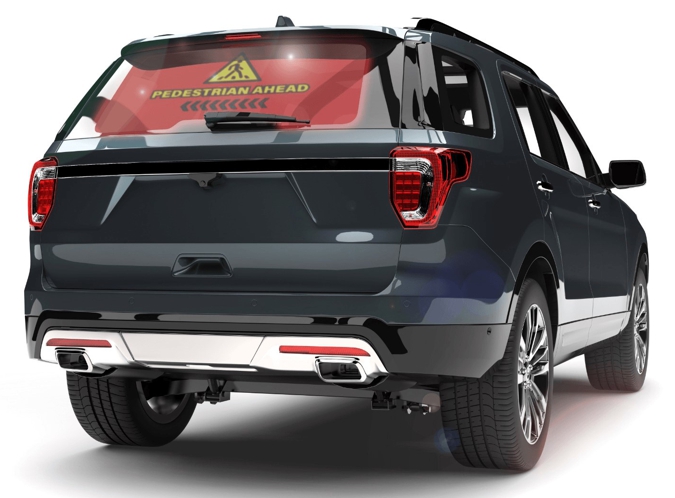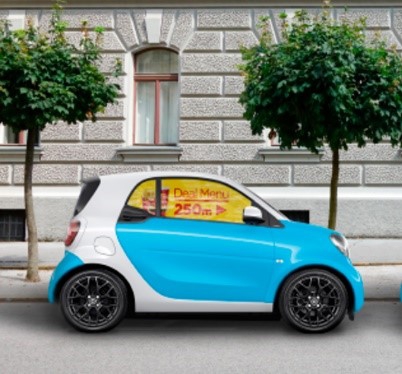DLPA129 March 2022 DLP3020-Q1 , DLP5532-Q1
1 Introduction
New transparent display technologies are enabling car manufacturers and ride hailing companies to turn virtually any transparent surface into a bright colorful display. Front, side, and back windows as well as panoramic sunroofs can now be turned into interior or exterior facing displays. Target applications include location-based advertisement, vehicle to vehicle (V2V) and vehicle to pedestrian (V2P) communication, passenger, driver greeting, roof, infotainment, and driver assist displays. Figure 1-1 and Figure 1-2 show examples of V2V and location-based advertisement window displays.
From an advertisement perspective, it is becoming common to see taxis or ride hailing vehicles driving around major US cities with large rooftop mounted LED displays. Location-based-advertisement allows marketers to target customers when they are within a certain geographical area or distance from a retail location. Messaging can be tailored based on location, time of day, driving routes, and even weather. Ride hailing companies such as Uber and Lyft are running location-based-advertising services in several major US cities with the goal of increasing revenue and driver pay [1] [2]. Roof mounted LED advertisement displays produce large, bright images but have several disadvantages including reduced vehicle fuel efficiency due to drag, road noise, high power consumption, high cost, difficulty in removing the display when not in use, and arguably unappealing aesthetics.
 Figure 1-1 V2V Communication Back Window
Display
Figure 1-1 V2V Communication Back Window
Display Figure 1-2 Location-Based Advertisement Side
Window Display
Figure 1-2 Location-Based Advertisement Side
Window DisplayAs an alternative to rooftop mounted displays, technologies such as PDLC smart glass films that support transparent and translucent states are being evaluated for mobile advertisement. Instead of installing a roof mounted display, the existing back or rear side window of a vehicle can be used to display advertisement. When the PDLC film is in the translucent state and illuminated by a DLP projector, the film acts as a rear projection display. When the film is in the transparent state, the window provides clear, unobstructed visibility. After picking up passengers, ride hailing companies can turn off the advertisement by placing the window into its transparent state, providing passengers full visibility of their surroundings during the ride.
Window and cartop LED displays both face some amount of regulatory challenges and uncertainty. Regulations around mobile advertisement are not fully defined and dependent on the region, down to the municipality. In addition, there are also country specific regulatory requirements defining what can and can’t be displayed on a vehicle window in terms of color, location, and dynamic vs static content. The ability to support both transparent and translucent states provides flexibility to adapt to the ever-evolving regulatory environment.
A significant design challenge with any window display technology is achieving brightness levels high enough to support daytime viewing. Supporting night time viewing is relatively easy but in order to maximize advertising revenue, daytime viewing should be supported. Supporting a large display area is another design challenge, with the larger the display area, the more projector lumens required. Doubling the display area requires 2x the projector lumens in order to maintain the same display brightness.
Display brightness measured in candelas per meter squared (cd/m2) or Nits is a function of the film efficiency, screen gain, display size and projector illuminance. As shown in previous work on display brightness requirements, the luminance contrast ratio (LCR) should also be considered [3]. TI and Gauzy have collaborated to design, build and characterize a PDLC smart glass display system using a high-lumen projector co-designed and developed with TQ Optoelectronic. This document provides an update on Gauzy’s PDLC technology, TI’s high lumen DLP projector reference design built by TQ Optoelectronics, and discusses the characterization results of the high lumen projector / PDLC smart glass system.